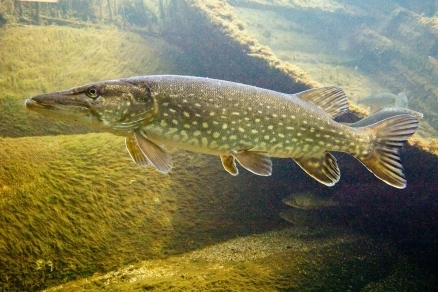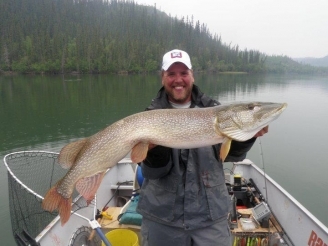Northern Pike (Biology)
Contents
Northern Pike
The Northern pikeEsox luciusis inthe family Esocidae, a predatory group of freshwaterfishes. The remaining members ofEsocidaebeing thepickerels Esox americanusandEsox niger, themegapredatory Muskellunge Esox masquinongy, and the Amur pike Esox reicherti. There is some debateon whetherthe Amur pikeis a distinct species fromor a sub-species of E. lucius. For the purposes ofthis article we will treatE. reicherti as the same speciesas E. lucius.Due to their voracious appetite and large size, Northern pike are a popular game fish for recreationalanglers in North America and Europe. Esocids as a familydate backto theCretaceous period.The Paleocene fossil Esox tiemani ismost similar in morphologyto the Northern pike indicating thatE. luciusistheleast derived of the extantspecies in the family Esocidae andhas common ancestors that date back62 million years.
|
12-14" juvenile Northern pike from the Kankakee River, Illinois. Photo credit: Uland Thomas |
|
1.3 meter (50") Northern pike from Manitoba, Canada. Photo credit: Jerry Dunlop, www.dunlopfishing.com 1.3 meter (50") Northern pike fromStark Lake, Northwest Territories, Canada. Photo credit: Nathan Musclow JuvenileE. luciusfeeding on a trout (salmonidae)fingerlingin captivity. Notice how the young pike shifts the prey in the mouthto swallow the prey head first. Video credit: Bernt René Voss Grimm Conservation Status |
|
Scientific Classification Kingdom: Animalia |
Physical Description
E. lucius is an elongate, tube-shapedfish with the median fins seton the posterior potion ofbody. The caudal fin is forked with theends rounded. Pectoral fins are locatedventrally just posterior the operculum (gillcover). Pelvic fins are locatedventrally on the middle regionof the body.Thesnout has a duck-bill shape and the mouth is lined with sharpcanine teeth on the lower jaw and small fine teeth on the upper jaw.Adults have white or yellow bean shaped spotsagainst a dark green or brownbackground on thelateral portions of the body.A solid dark green or browncolorationcovers the dorsal region of the body.Theventral region from thesnout tothe anal finis pearl white.The fins have dark black markings against a yellow, red, or orange background.Fingerlingpikeoften have a tiger-like pattern with yellow lines against a green background. Diagnostic features include1.)cheek fully scaledandhalfscaled opercle and 2.)five to sixsubmandibular (lower jaw)pores. Northern pike can attain lengths of up to 1.5 meters and weigh30+ kilograms.
Reproduction
Spawning occursin late winter or earlyspring when thewater temperatureis on average6-14ºC, depending on the region. Males reach sexual maturity at 1-2 years of age (16-18 inches in length)and females at 2-3 years of age (20-22 inches in length). The onset of sexual maturityoccurs fastest in regions where pike have highest growth rates.Like most other bony fishes (Osteichthyes), Northern pike exhibit external fertilization in whichthe eggs are fertilized and develop outside of the femalesbody(termed oviparous). During the month long spawning seasona single female is accompanied by multiple males. Femalesrelease eggsinvegetationand males fertilize the eggs by releasingsperm and using the caudal fin to mix the gametes. Besides the actual spawning event, adult pike show no parental care.Eggs hatch intoyolk-sac embryos 12-14 days after spawning. Thenew-born pike attach to vegetation and absorb theyolkforabout 10 days.After which,the pike become free-swimming and begin exogenousfeedingon zooplankton. By the time other fishes are spawning in late spring or early summer, the fingerling pike are already a couple inches in length and can prey upon the spring/summerrecruitment. Certain European populations of northern pike are unique in that they are anadromous, migrating from theGulf of Bothniainto freshwaterrivers to spawn, much likewell-known salmon(salmonidae) runs.
Lifespan/Longevity
Like mostfishes, pikehavewhat is calledindeterminate growth, meaning they will continue to grow throughout the entire lifespan. Growth tends to increase rapidly in young fishes and slows abruptly after sexual maturity. On average, pike live around7 years in the wild, the equivalency of a meter long pike. However, larger pike can be as old as 25 years old. In captivity, pike have lived to 75 years of age.
Distribution & Movements
Northern pike, as is evident in the common name, are distributed in the northern hemisphere of North America, Europe, and Asia. Thedistribution of the Northern pikeis unique in that ithas themost widespreaddistribution of any exclusively freshwater fish.Burbot Lota lotais another freshwaterspecies with circumpolar distribution,though, notas widespread as the Northern pike's.Pike have been intentionallyintroduced in many non-native countriesincluding Australia, New Zealand, Madagascar, Ireland, and Spain. Due to their predatory nature, pike have also been introduced in historically absent areas of native countries to support sport-fishing and to control over-population ofprey species.
Habitat
Northern pike are temperate, cool-waterspecies that can be found in just about every type of freshwater habitat.Primehabitatis vegetated areas of lakes and backwaters ofrivers with plenty of forage. Adults lurk within and around vegetation waiting to ambush prey with quick bursts of speed. Larval pike also utilize vegetation as nursery grounds and as pike grow juvenile pike remain near vegetation to hide from larger piscivores and ambush prey.
Food & Feeding Habits
Northern pike are chiefly piscivorous, but are opportunistic predators thatwill feed on crustaceans, amphibians,birds, small mammals, andeven otherpike. ALie-in-wait technique of prey capture is evident by the anteriormorphology of Northern pike. Like the oceanic barracudas (Sphyraenidae),Northern pike have elongate bodies with the median fins set on the posterior portionof the body and a low aspect ratio caudal fin. Fishes with thistype ofbody plancan rapidly acceleratein short bursts of speed.A large gape and expandable stomachgive pike the ability of swallowing large prey. Sharp teeth allow northern pike to capture prey and maneuver the prey inthemouth so that the prey item is swallowed head first. This is critical as a large number of fishes have sharp spines in their fins, which would prevent swallowing if not ingested head first. The eyes of pike are highly mobile and can locate fast moving prey. Groovesalong the snoutjust anterior the eyes allow pike to judge distance when locking onto prey.The lateral line system, a line of pores along each side of the body and around theface, detectdistortions in the watercolumn aroundthe fishproviding anadditional tool forprey location. The lateral line system is so effective that blind pike have been documented surviving in the wild.
Predation
Larval and juvenile pike can fall prey to a great number of animals including other fishes, mammals, birds, and insects. However, as pike grow to adulthood theyquicklyearn rank in the top of the food chain with limited predators, humans being one of the very few.
Economic Importance for Humans
Esox lucius is a popularfood for some cultures as pike can grow large and containa goodamount of meat. However,pike also containnumerous smallbones (difficult to fillet)and can harbor large quantities of parasites. So, pikeneed to be cooked thoroughly if eaten. The countries with the largestcommercial catch of Northern pike in1999 were Finland and Russia.Northern pike are also an important game fish and arestocked extensively in North America and Europe for sport-fishing. Anglers use fast moving artificial lures like spinner-baits to trigger thepredatory instincts of pike. Live baits such as suckerfish (Catostomidae)are also popular baits to catch large pike.
Threats & Conservation Status
Pike are a least concern speces according to the IUCN's red-list. The widespread distribution, lack of predators, and popularity as a game fish ensure the Northern pike's existance for the foreseeable future.Although, there is onethreat to Northern pike,the destructon of spawning habitat. Wetland and marsh habitathave been greatly reduced due to development in the native range of the Northern pike.
Further Reading
- Bosanko, Dave. 2007. Fish of Michigan Field Guide. Adventure Publications, Inc., Cambridge, Minnesota.
- Cooke, Fred, Hugh Dingle, Stephen Hutchinson, George Mckay, Richard Schodde, Noel Tait, & Richard Vogt. 2008. The Encyclopedia of Animals: A Complete Visual Guide. University of California Press, Berkeley and Los Angeles, California.
- Freyhof, J. & M. Kottelat. 2008. Esox lucius in IUCN 2012. IUCN Red List of Threatened Species. Version 2012. <www.iucnredlist.org>.
- Helfman, Gene S., Bruce B. Collette, Douglas E. Facey, & Brian W. Bowen. 2009. The Diversity of Fishes: Biology, Evolution, and Ecology. 2nd edition. Wiley-Blackwell West Sussex, United Kingdom.
- Page, Lawrence M., & Brooks M. Burr. 2011. Peterson Field Guide to Freshwater Fishes of North America North of Mexico. 2nd edition. Houghton Mifflin Harcourt, New York, New York.
- Raat, Alexander J.P. 1988.Synopsis of Biological Data on the Northern Pike. Food and Agriculture Organization of the United Nations. No. 30 Rev. 2.




